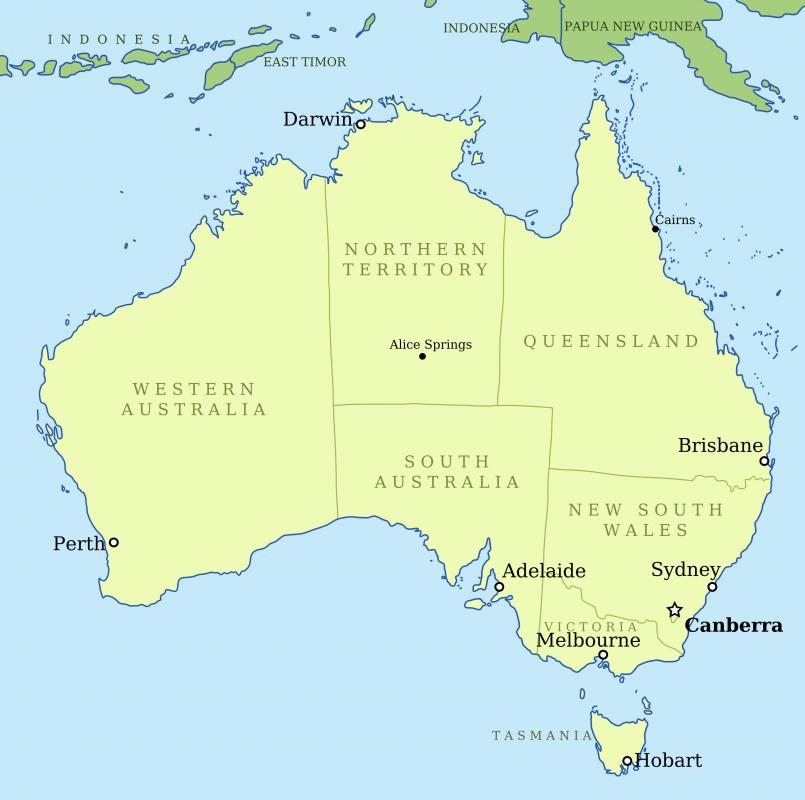At AllThingsNature, we're committed to delivering accurate, trustworthy information. Our expert-authored content is rigorously fact-checked and sourced from credible authorities. Discover how we uphold the highest standards in providing you with reliable knowledge.
What Is the Grey Teal?
The grey teal, also known as Anas gracilis or the dabbling duck, is a species of duck found primarily in Australia as well as in some parts of New Guinea, New Zealand, the Solomon Islands, and Vanuatu. Dabbling refers to this duck's habit of filtering mud or water through its bill as a means of finding small food sources. Like other types of teal ducks, this species gets its name from the wide blue-green stripe found on the head of the common teal, Anas crecca.
This species of duck is almost entirely brownish grey, with a white throat and dark greenish bill. Its size can range up to nearly 19 inches (about 48 cm) in length. The male grey teal is somewhat larger than the female but is otherwise difficult to distinguish from the other sex. Female grey teals have a loud, repeated quack resembling human laughter, while the males' vocalizations are much quieter and briefer.

Due to visual similarities, the grey teal is often confused with a related species, the chestnut teal. Coloring of the two species is remarkably similar, with the exception of the throat area, which is white in the grey teal and brownish in the chestnut teal. The grey teal has a habit of mixing with other species such as the chestnut teal in areas where the two types of duck cohabit, making it more difficult to distinguish one species from another.
This species of teal has been known to breed at any time of year, but will not breed during a year when there is drought or other unsuitable conditions. Grey teals often nest on the ground near a water source but can also be found in hollow trees or rabbit holes. The female grey teal lays up to 14 eggs, with an average of eight eggs per clutch, and covers the eggs with downy feathers for warmth.
A typical meal could include plants, insects, seeds, or various types of crustaceans. Teal ducks often gather in flocks for feeding. The grey teal is a nomadic duck species that has been known to relocate to find better feeding and breeding conditions. It is believed that grey teals first appeared in New Zealand in the 19th century after their native land of Australia was visited by a harsh drought.
Also found in New Zealand are Anas aucklandica, the Auckland Island teal, and Anas nesiotis, the Campbell Island teal. These are flightless species. They are considered endangered in New Zealand.
Frequently Asked Questions
What is the Grey Teal?
The Grey Teal (Anas gracilis) is a dabbling duck native to Australia and some parts of Oceania. It is known for its adaptability to various freshwater habitats. This bird is predominantly grey with a lighter face and underparts, and it has distinctive red eyes. It feeds on aquatic vegetation, invertebrates, and seeds.
Where can you find the Grey Teal?
Grey Teals are widely distributed across Australia, New Zealand, and some Pacific islands. They inhabit a range of wetlands including lakes, swamps, and rivers. Their habitat choice is influenced by water availability, and they are known to travel long distances in response to changing environmental conditions.
What does the Grey Teal eat?
The Grey Teal's diet consists mainly of aquatic plants, seeds, and small invertebrates. They feed by dabbling at the water's surface or by up-ending, rarely diving underwater. Their feeding habits are opportunistic, and they will take advantage of food sources as they become available.
Is the Grey Teal a migratory bird?
Yes, the Grey Teal is partially migratory. While some populations are sedentary, others undertake significant movements in response to rainfall and water availability. They are known to migrate from inland regions to coastal areas during drought periods, showcasing their adaptability to varying environmental conditions.
How does the Grey Teal breed?
Grey Teals breed opportunistically, often in response to heavy rains and abundant water. They nest near water in concealed locations, using reeds and grasses to build their nests. Females lay 7-11 eggs, which they incubate for about 26-30 days. The species is known for its high breeding potential.
What is the conservation status of the Grey Teal?
The Grey Teal is currently classified as Least Concern by the International Union for Conservation of Nature (IUCN). This status reflects the bird's wide distribution and large population size. However, habitat destruction and changes in wetland ecosystems could impact their numbers, making ongoing monitoring important for conservation efforts.
AS FEATURED ON:
AS FEATURED ON:











Discuss this Article
Post your comments